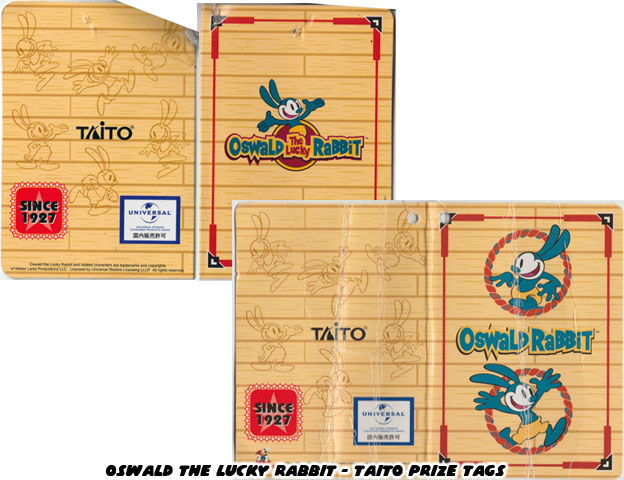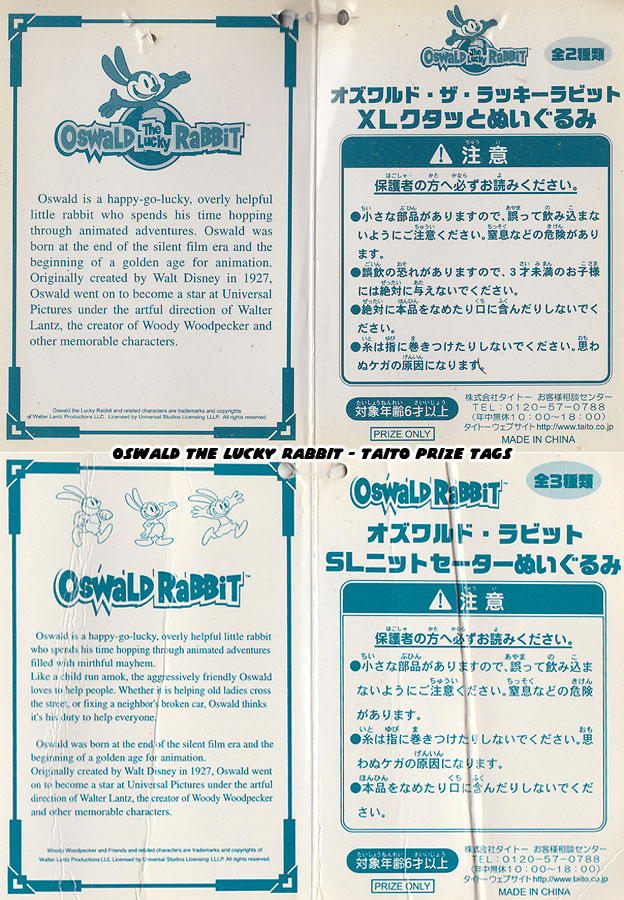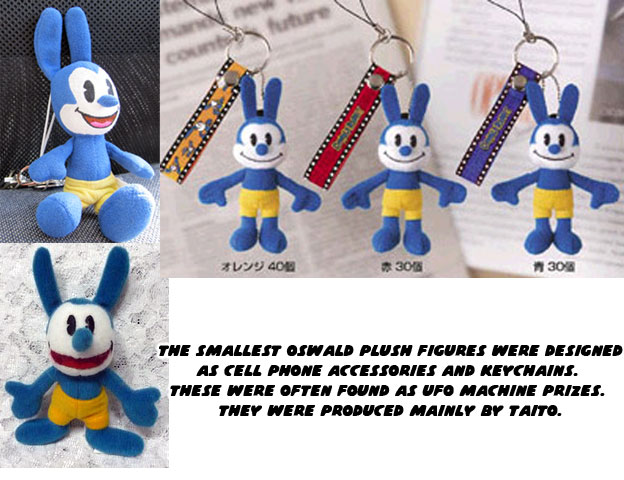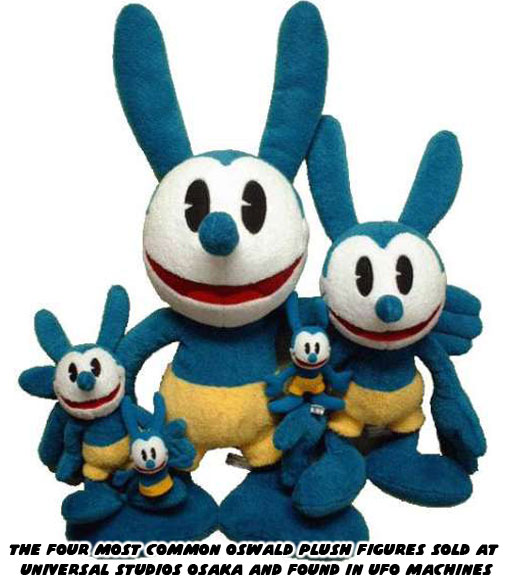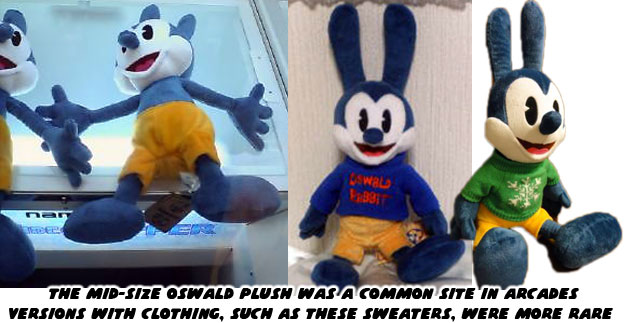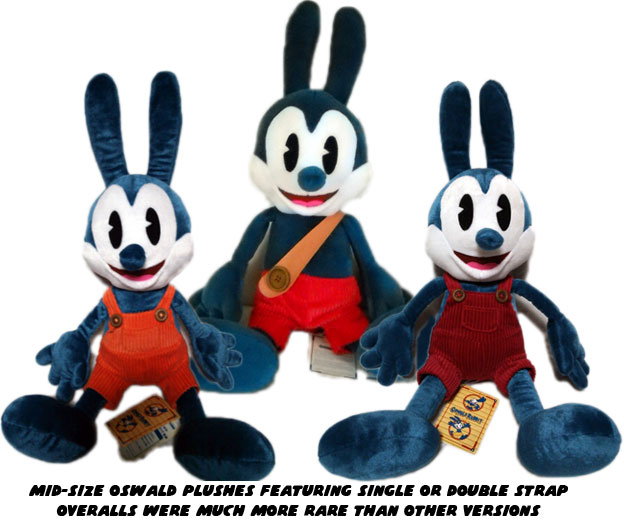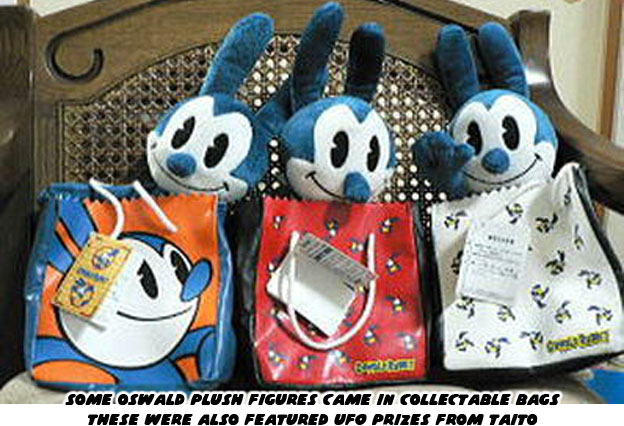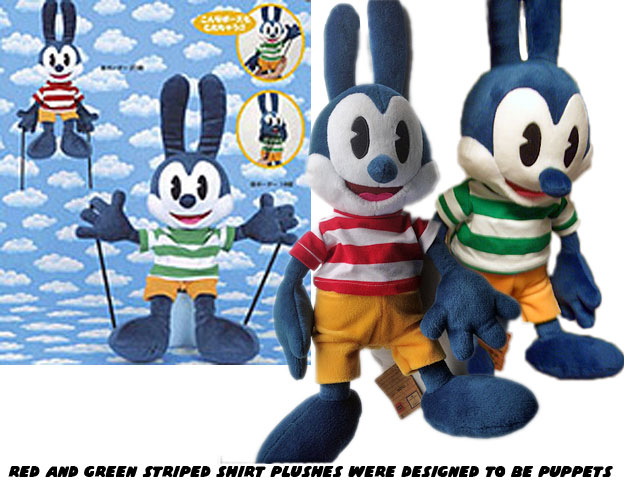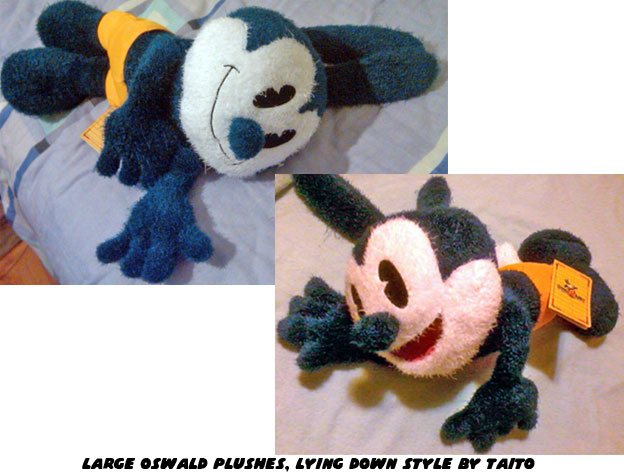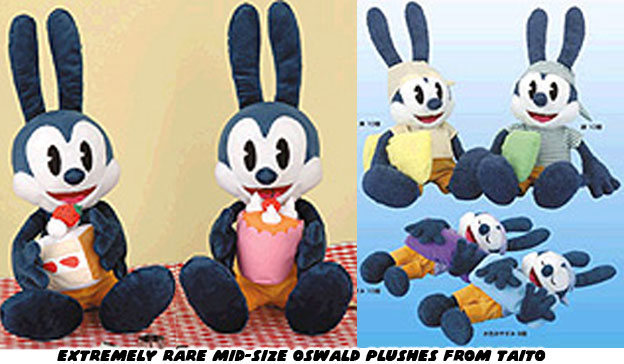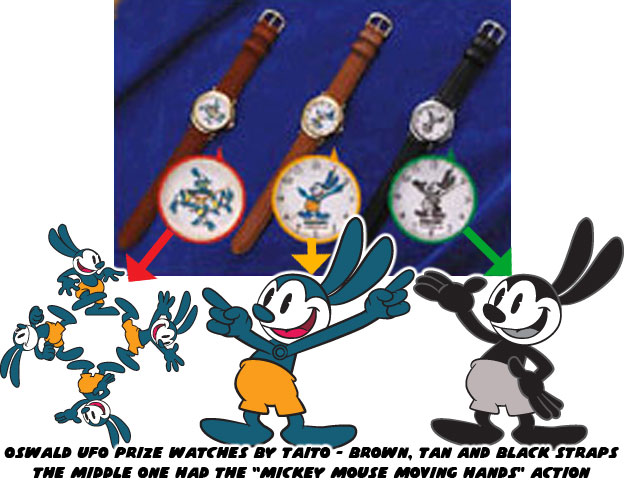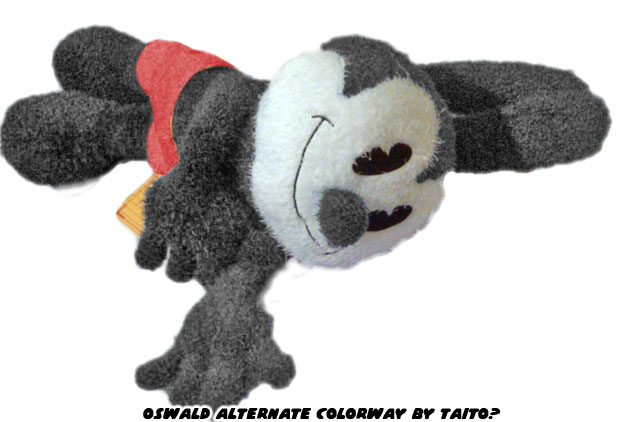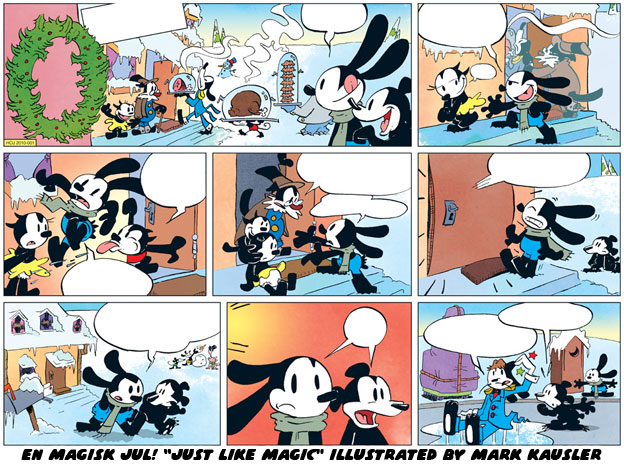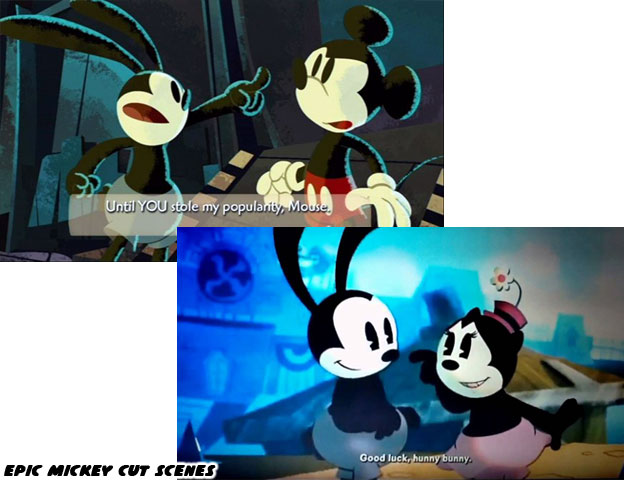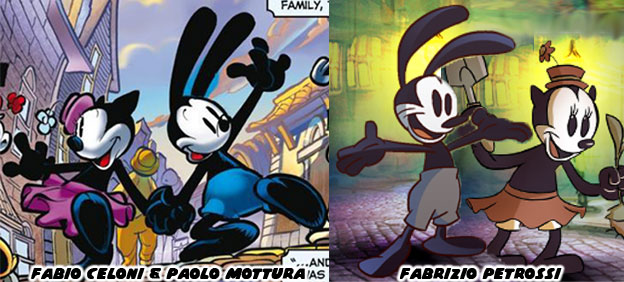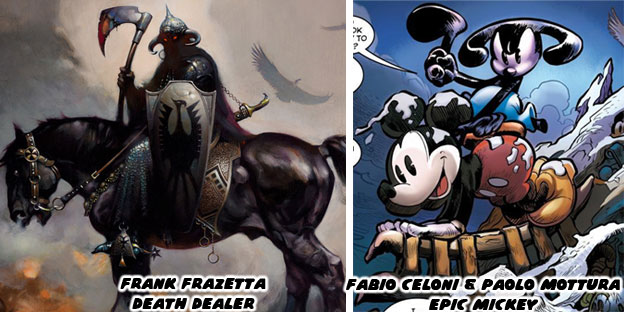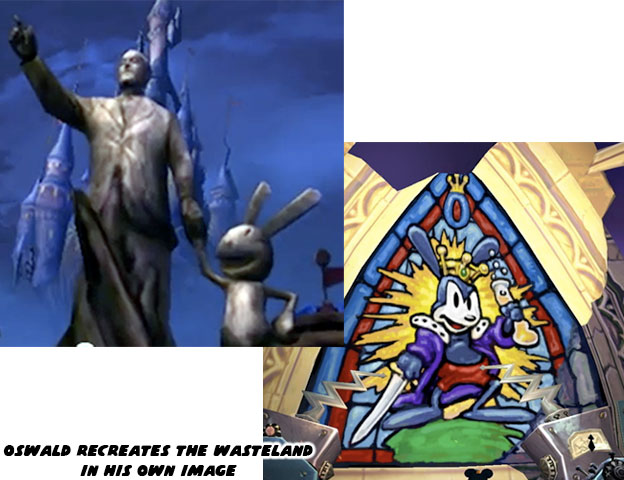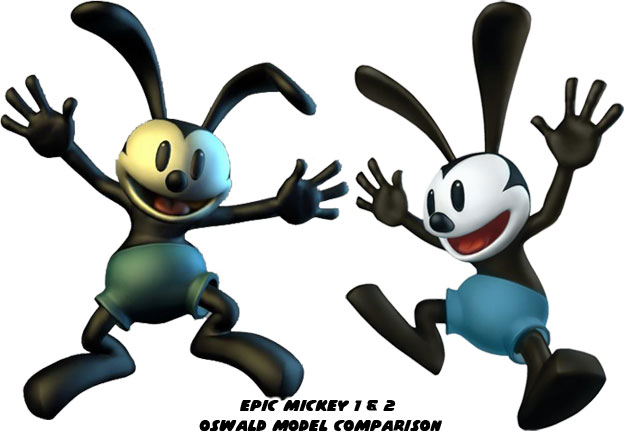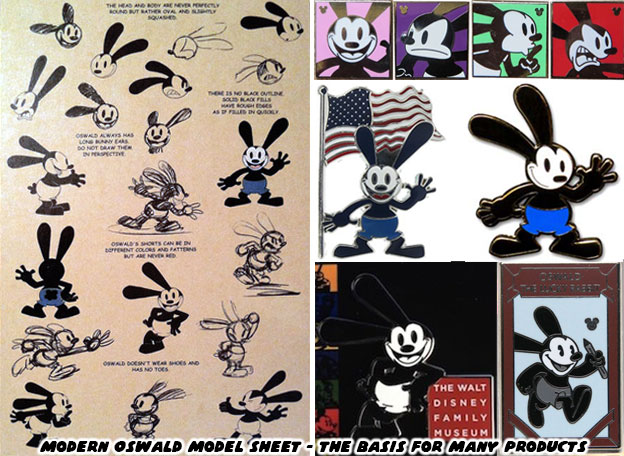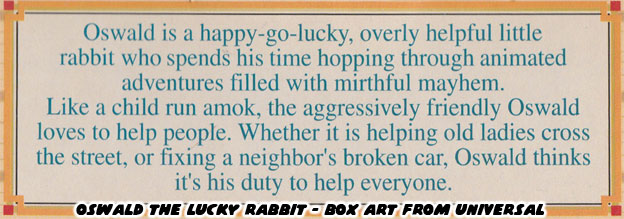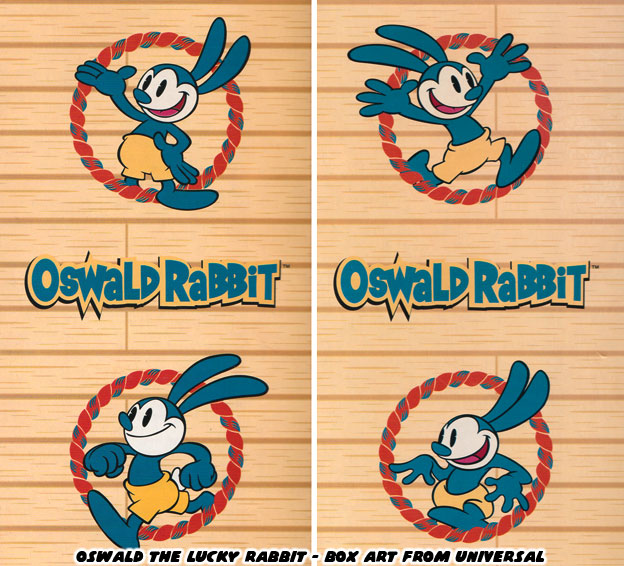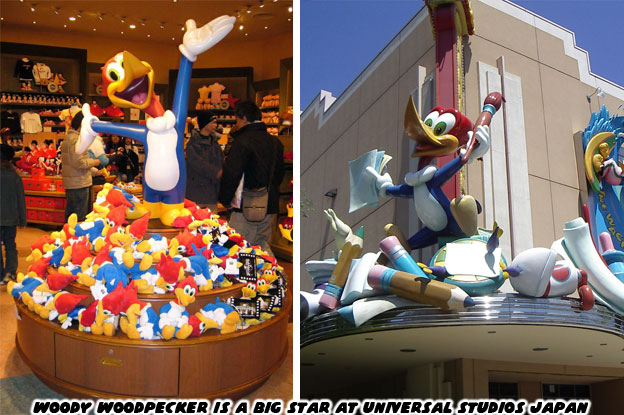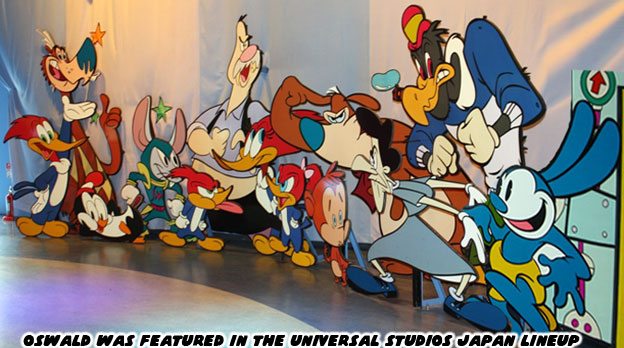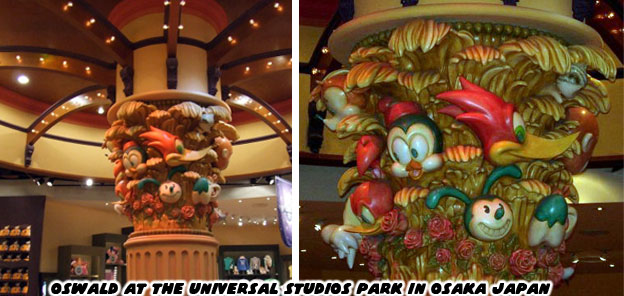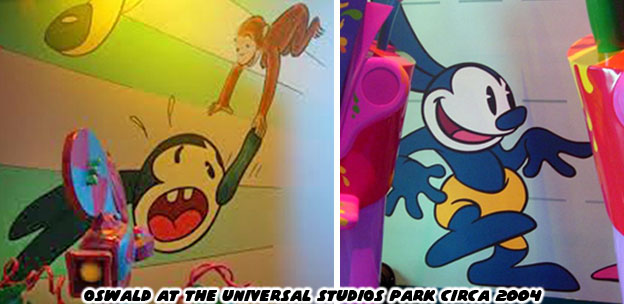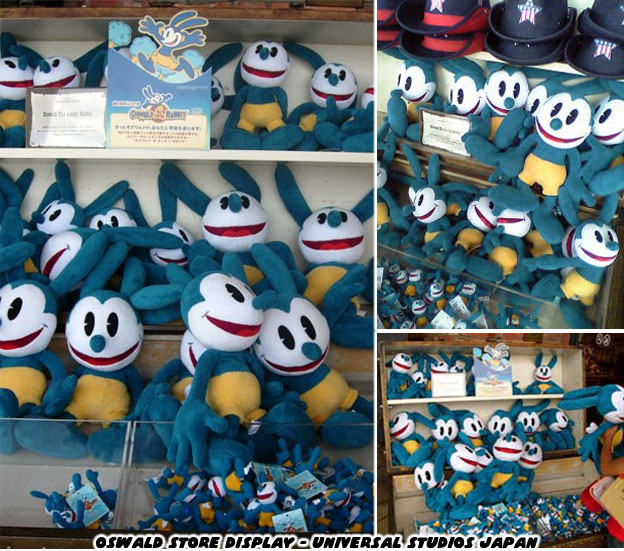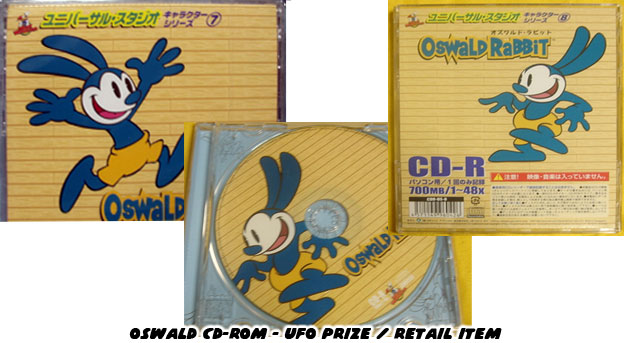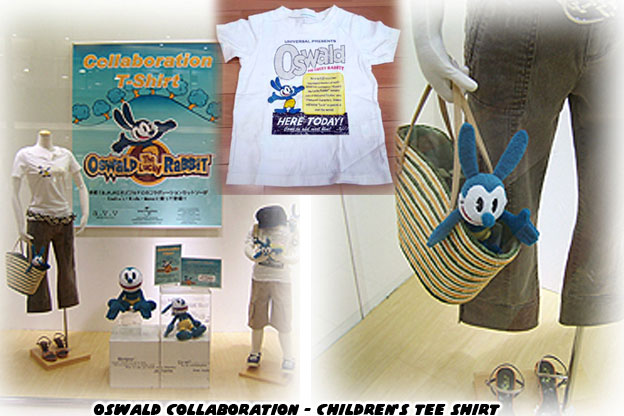In the previous blog I mentioned that Oswald had become a popular name in Japan. Between 2004 and 2005 the character had generated a lot of buzz overseas and even some in the USA. He appeared at the Universal Park in Osaka as well as on various arcade prizes from Taito. The character underwent some subtle changes shortly after Disney had required the character. The early licencors, between 2006 and 2007 used designs that were very fluid and reminiscent of the Taito art. The character had a more oval or egg-shaped head, skinnier arms and legs and long rounded feet. By 2008 the character had been standardized for official art and merchandise.
In early 2006 Oswald's rights were transferred back to Disney. This trade was not really big news in the USA with the exception that sports commentator Al Michaels was the original reason that Disney and NBC / Universal had struck a deal. Oswald was thrown in as a sign of good faith between the President of Universal and the CEO of Disney. Animation fans and theme park devotees were the only ones that really took notice of the news. Getting the rights back meant that Disney had to work double time in reintroducing the character.
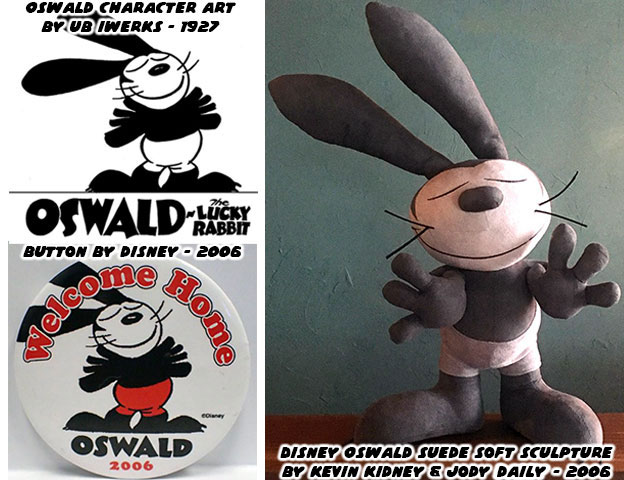
Two of the artists instrumental in getting Oswald some exposure were Kevin Kidney and Jody Daily. The duo had created some of the best merchandise in the history of the company. Everything from dinnerware to shirts, mugs, statues and toys came out of their studio. They were experienced artists, imagineers and more important, they were fans of Walt Disney. The two were mindful of Walt's legacy and did a great job of honoring it on every project they worked on. They were students of every era of the company and especially of the theme parks. Aside from the vinyl Cutie figure that I had blogged about previously the studio wanted to release a high-end plush figure.
In 2006 Kevin and Jody created a wire armature of the rabbit, stuffed it with fiber and covered it in faux suede. The feet were filled with buckwheat or something similar so that he could stand on his own. This Oswald was modeled after the original art from Ub Iwerks, (dating back to 1926!) with details going all the way down to cord whiskers on the face and feet. Ub was the Disney animator that had a hand in creating both Oswald and Mickey Mouse. The Kevin and Jody figure was taken to shows to get the public interested in Oswald again.

In 2007 a figure that looked very similar to the concept sculpt was released at Walt Disney World. The plush was large and pricey, at about $60, but included the history of the character on the packaging. It reminded audiences "Before there was Mickey… there was Oswald." Today the figure can fetch several hundred dollars on eBay and specially shops. Only two pieces were made and Kevin and Jody sold both of them off at a Pop Gallery Retrospective in September 2016.
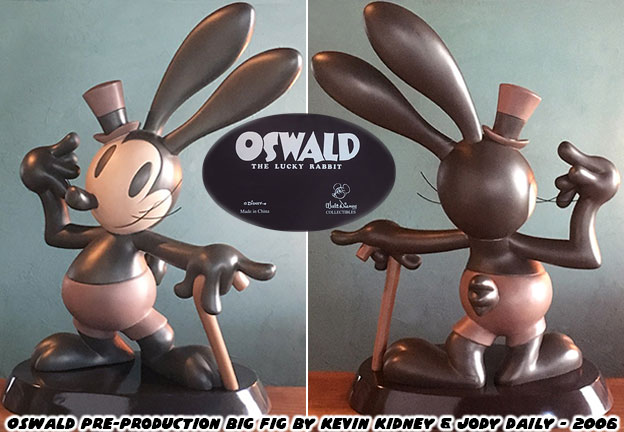
Something similar happened to the first "Big Fig" commissioned for the character as well. Kevin and Jody once again went back in time to get the inspiration for a collectible statue. They returned with a very vintage design. One of the earliest pieces of Oswald merchandise used the character designs from Ub Iwerks. In the Stencil Set from circa 1928 there were a number of stencils of Oswald in different poses. One of those was titled "The Sheik" and it featured Oswald wearing a top hat, holding a cane and twirling his whiskers. Oswald had actually appeared with a top hat in a few movie posters.
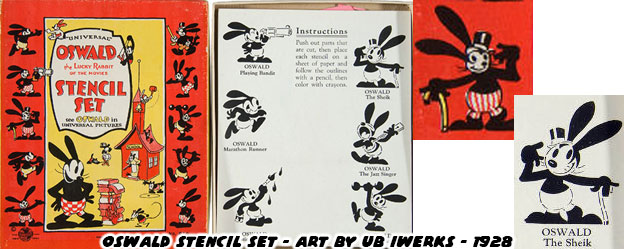
Note that the early shape of Oswald had yet to be finalized. He had more of an egg shaped head in the earliest designs. Many collectors showed interest in the figure but apparently not enough for the studio to follow through with a release. Six years later an Oswald statue was released but in the smaller "Mid Fig" format. The new sculpt was closer to the style sheets but lacked the insight and details that Kevin and Jody had dug up.
The original Oswald Big Fig was sculpted by Bo Tsai, who had sculpted hundreds, if not thousands, of the greatest Disney collectibles. It was painted in warm gray tones by Jody. In Kevin and Jody's words
"We even managed to produce a bottomstamp for the base using the 1920s name-type in the original Oswald shorts. Months after our little Oswald collection was given the axe, the artists of Disney Consumer Products released an Oswald "style guide" for use in new products for the Disney Store. The "new" Oswald was more streamlined and his original silent-movie-era crudeness was polished away to better fit modern-day expectations." There were two of the original resin big figs made. The first one disappeared into history and the other one, including the base, was auctioned off during the Pop Retrospective in 2016.
Disney consumer products created a very simple style guide and almost all of the merchandise produced over the next decade, in both Japan and the USA, worked directly from the model sheet. Buttons, clothing, pins and various items all relied heavily on the guide. This lack of originality stripped the character of his personality. All of the details that Kevin and Jody had captured were stripped away in the first round of merchandise featuring the character.
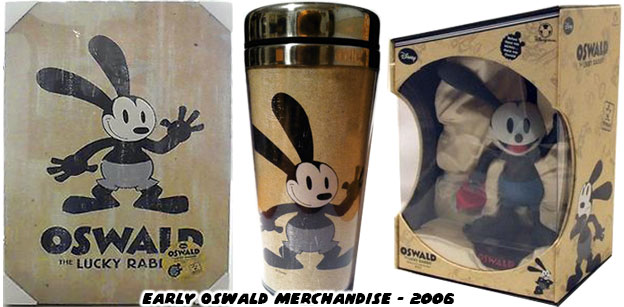
Bob Iger, CEO of Disney, knew that animation was not necessarily the best medium to get Oswald in the minds and hearts of new Disney fans. Oswald would have to be featured in a big budget videogame. The seeds for Epic Mickey were planted by a group of interns but it would take many years to see a finished product. In the meantime Oswald needed to be re-branded. The character had to become synonymous with Disney but Oswald merchandise could not simply be dropped in the parks or Disney stores overnight. Little by little the company had to ease Oswald onto consumers.
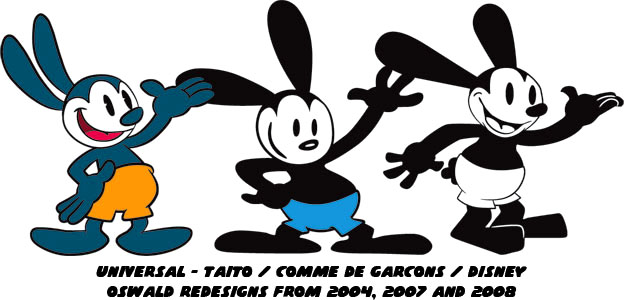
Tee shirt collaborations seemed to be the best way at getting the rabbit out in the world. This was something that Universal understood. Their children's tee shirt line had two known designs, one of which gave a brief history on the character. There were other shirts in the works, specifically for adults, but they were not released pending on the success of the kids line. Despite having the slogan "Come in and meet him" there was never an Oswald walk-around character in the Universal park. I have no doubt that there was one in the plans.
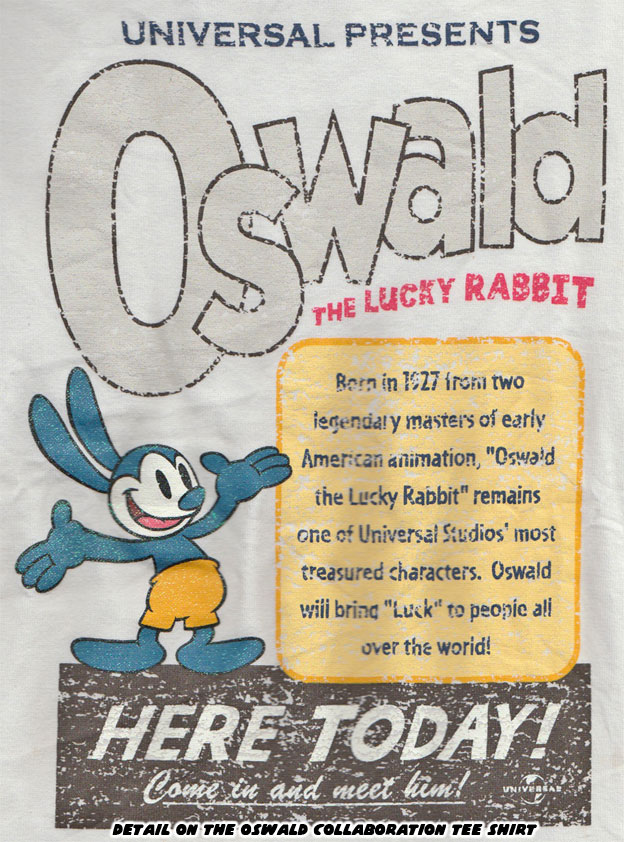
In the short time while the rights were being transferred back to Disney a South Korean clothing manufacturer named Rocket Salad released a sweatshirt line featuring Oswald. It was assumed that Disney would redesign the character rather than use the most recent Universal version. Disney did not have an official model sheet available at the time Rocket Salad was releasing their items. What the company did was reprint the cover a children's book from the 1930's. While this was a Lantz design it looked old enough that audiences wouldn't necessarily credit it to Universal.
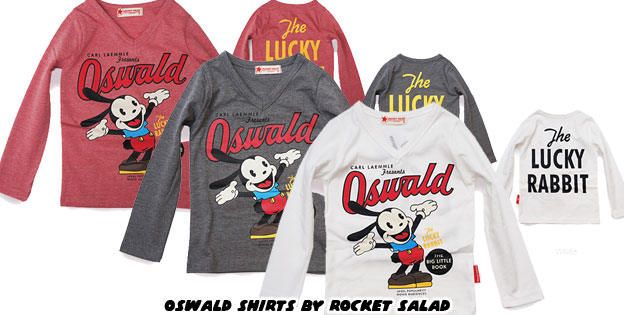
The first clothing partner that actually ran with a new redesign of Oswald was Comme De Garcons. The company was very trendy and also very pricey. Their tee shirts could go for well over $150 and were mostly sold in Japan. Their group of designers worked with Disney to reinvent Oswald while maintaining a classic look. The first thing the studio did was drop the Universal colors and make Oswald black and white. To prevent any confusion between the character and Mickey Mouse it was decided that Oswald needed to have blue shorts or white shorts from that point forward. The fashion brand actually printed metallic gold shorts for one design. The head of Oswald was more egg-shaped than oval. There were three distinct poses that the company used for shirts and even a wallet. This version of Oswald had rounded fingers and feet like the Universal one but his proportions were slightly different. Oswald's belly was larger and almost the same size as his head.
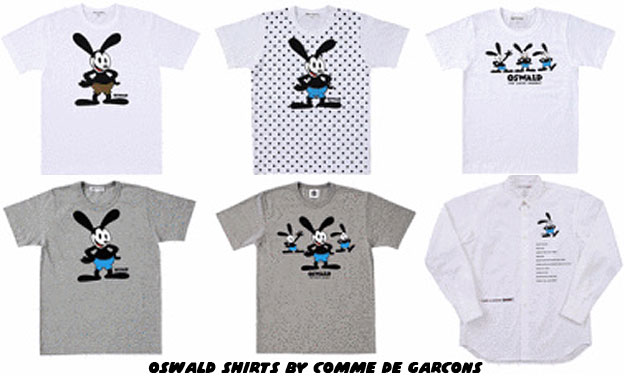
About a year later a second fashion label debuted its Oswald collection. Stussy, a popular street brand, was the first to use the contemporary designs of Oswald. While Stussy items were available in the US, these specific shirts were available in Japan only. The designers at Disney had narrowed down the features, poses and even attitude of the character. The fingers and feet were squared off and the head was more round than oval. The character looked more rigid than the Universal or Comme De Garcons figures. Stussy printed the various poses from the model sheet on the front of their shirt. It was interesting to note that one shirt they printed featured Oswald wearing red shorts. Oswald had been standardized at this point. Almost every appearance of the rabbit after 2008, whether on clothing or other merchandise, featured a pose pulled directly from those created by Disney.
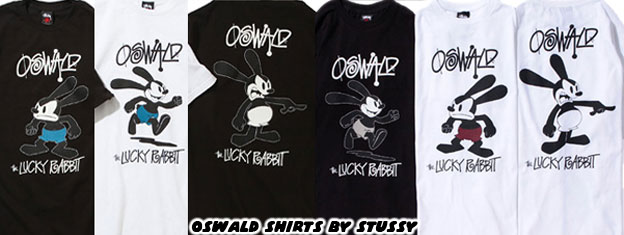
Stussy highlighted something important about collaborations. In order to get audiences to spend $100 on a shirt there had to be some sense of quality and exclusivity. The shirts were created in a limited number and to further sweeten the deal they came with an exclusive Bearbrick (sometimes written as Be@rbrick). These small vinyl figures were produced by Medicom. Exclusive figures, such as the Oswald phone strap version, were highly prized by collectors. Many bought shirts just for the figure.
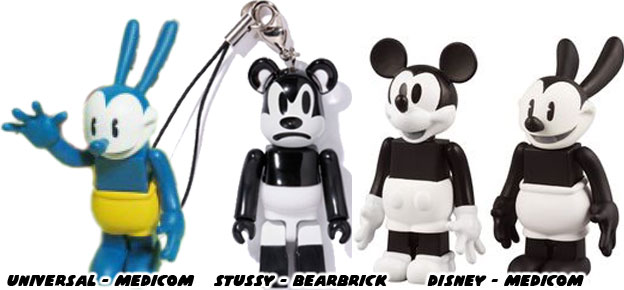
Medicom had actually released a line of collector figures featuring Woody Woodpecker and friends during the 2004-2005 Universal era. These "Kubrick" figures kept the shape and design of the cartoon mascots, as opposed the the bear-shaped Bearbrick line. About a year after the Stussy collaboration Medicom released a two-pack of Kubric figures celebrating the return of Oswald to Disney. This time it was a black and white Mickey Mouse and Oswald bundled together for collectors. The Oswald figure was based on the earlier Universal model.
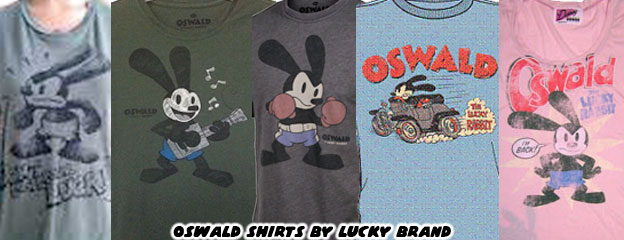
The first US shirt collaboration was with Lucky Brand Jeans. The stores sold tee shirts featuring Oswald around 2008. This was essentially the first place for people in the know to get a modern Oswald item and show their support. While a few of the shirts featured one of the standard poses from Disney's model sheet the majority of the shirts were original works of art. They captured much more personality than any other shirt line before or after. Oswald showed a broad range of emotions in the various styles, from happy to sassy. It was the first time in ages that a group of artists were able to recreate the elements that made Oswald an icon in the first place. Granted, he didn't flash a gun in any design, but the art would have made Ub Iwerks proud.
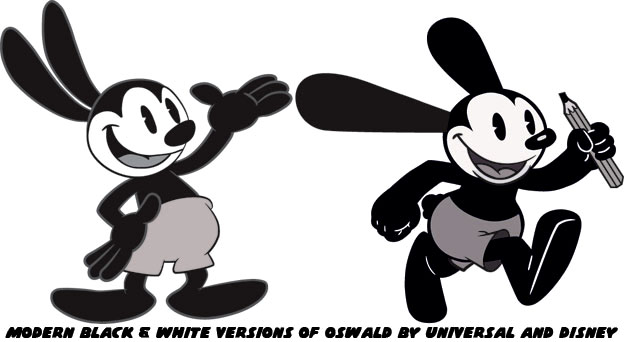
Oswald remained relatively unchanged by the Disney company since 2008. That was until the re-opening of Disney California Adventure in 2012. The park featured a new Buena Vista Street, Cars Land and other attractions. At the gate there was a new store, Oswald's Service Station. The proportions of Oswald were adjusted slightly on the logo created for the station. He was a fraction shorter and his body and head were almost a perfect 1:1 ratio. His eyes even went from perfect ovals to pie-eye pupils. A few products were sold with this specific version of Oswald.
The majority of pins featuring the character were rooted more on the designs from 2008. There were a couple of pins that had rabbits that looked more like the Comme De Garcons version but more or less the reboot of Oswald was complete. I would like to point out how similar the pie-eyed figure was to Universal's redesign. Both companies came to the same conclusion in the end, although sometimes I wonder if the designers at Disney did not borrow some elements from Universal. Certain design elements, the weight of a line, the curve of a figure, the scale and proportions could make a cartoon mascot look timeless even though they were created in the 21st century.
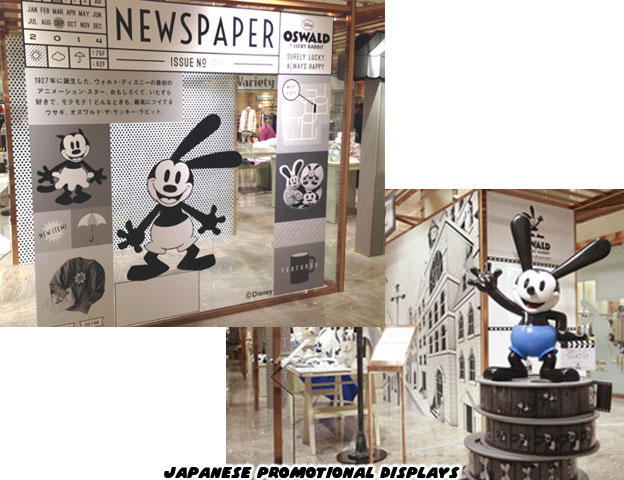
Japan never lost its love of all things Disney, especially not of Oswald. Since regaining the rights to the character every few seasons the Tokyo Disney Resort unveils a new lineup of Oswald merchandise. They never reuse the same designs but start from scratch each time. Some of the earliest Oswald merchandise were leather bags embossed with the character and some home good items. A dedicated campaign would reveal itself around 2010-2011.
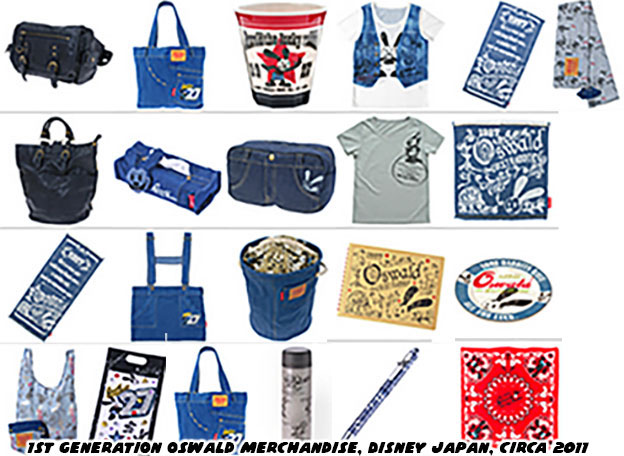
The earliest dedicated campaign mixed Oswald with Western style denim. There were bags, aprons, pencil cases and laundry bags made of the material featuring a leather Oswald tag. This collaboration was inspired by a crossover that Disney had with Edwin, a jean company out of Japan that had made a few Oswald figures out of their material, complete with tags. A few of these pieces still turn up from time-to-time on the Japanese auction sites. The turnaround for this merchandise was quick in Japan. Denim would give way to something completely different, such as bright colors and polka dots, a year later it might be naval inspired stripes. By comparison the merchandise featured at the Oswald Gas Station in Disney California Adventure had changed little over six years. In 2016 Japan had gone full circle and had released entirely new Oswald merchandise, this time revisiting the denim campaign.
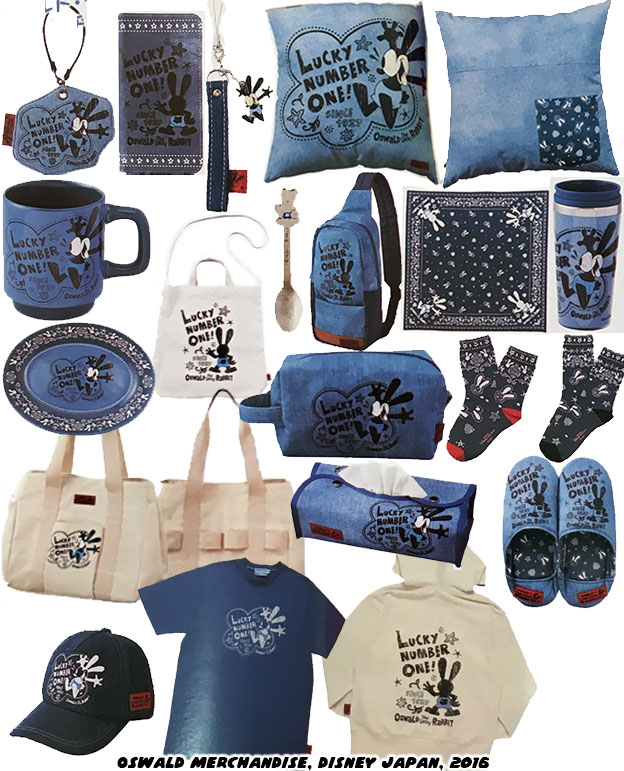
In Japan there are often Disney collaborations where items featuring specific characters are sold exclusively in specific stores. Oswald was the central character
at the fictional Spur City, a department store art collaboration from September 2014. Disney even had a large fiberglass statue of Oswald made just for the season. Chances are this figure might not be seen again in any other store or even at the park.
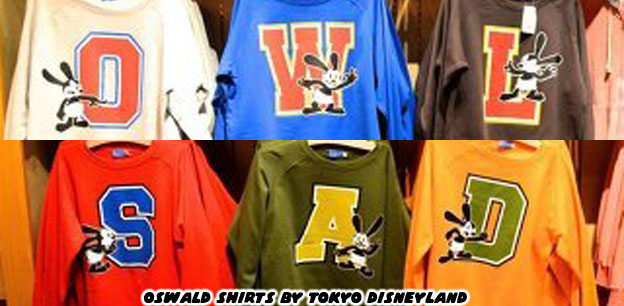
In the Japanese theme parks limited run tee shirts were nothing new. Some of the latter Oswald exclusives were letterman style sweatshirts. Oswald was featured prominently over one of the letters from his name. The poses used were pulled right from the model sheet. These were some of the most unoriginal designs from Japan but at least they only lasted one season. In the US Disney parks the Oswald merchandise has gone relatively unchanged since 2012. If there were some merchandise created for outside the park then it might be for a large retail store like Target. There would be no fanfare, no custom store props, no Oswald statues celebrating the collaboration. Instead there would simply be some new shirts released alongside the items from every other licenser. I understand that in 2015, for the 60th Anniversary of Disneyland, Oswald may finally be getting new merchandise at his store in DCA. It would be a welcome change.

The character had found its rhythm in the US and Japan. The rest of the world was now catching up. In China Oswald was introduced in a 2011 campaign from the fashion label Pizza Cut Five. The poses had been seen previously on Stussy and Lucky Brand shirts. It was a small effort to get the character some exposure and certainly appreciated by the trendsetters. Oswald's final design evolution would happen around this time in the US. The next blog will look at how Oswald transitioned from 2D to 3D.
If you would like to sponsor me
please visit my Patreon page and consider donating each month, even as little as $1 would help make better blogs and even podcasts!
